I'll delve into various vegetables, providing their names in both English and Hindi.
Learning the names of vegetables in different languages, like English and Hindi, isn't just for linguistic curiosity. It has practical benefits such as:

Staple vegetable, versatile and rich in carbohydrates.

Technically a fruit, used extensively in sauces and salads.

Essential for flavoring, used in a variety of dishes.

Rich in Vitamin A, good for eyes, eaten raw or cooked.

Used in salads, rich in vitamins and minerals.
Versatile, used in curries, stir-fries, and as a low-carb substitute.
Nutrient-rich, used in salads, curries, and soups.
High water content, used in salads and sandwiches.
Sweet, used in stir-fries, salads, and stuffed.
Unique texture, used in various cuisines for dishes like Baingan Bharta.
Bitter taste, known for its medicinal properties.
Popular in Indian cuisine, used in curries and stir-fries.
Crunchy texture, used in stir-fries and salads.
Peppery flavor, eaten raw or cooked in dishes.
Earthy flavor, used in salads, soups, and as a natural colorant.
Sweet and starchy, used in curries and as a side dish.
Sweet and tender, used in soups, curries, and desserts.
Pungent flavor, essential in many dishes for its aroma.
Spicy and aromatic, used in teas, curries, and as a remedy.
Mildly spicy, eaten raw or cooked in stews.
Slightly bitter, used in curries and parathas.
Fresh and citrusy, used as a garnish and in chutneys.
Cool and refreshing, used in chutneys, drinks, and raitas.
Long, pod-like, used in soups and curries.
Mild flavor, used in soups, curries, and desserts.
Sponge-like texture, used in curries and stir-fries.
Small and crunchy, used in stir-fries and pickles.
Adds heat to dishes, used in various forms.
Sweet and starchy, used in curries and as snacks.
Starchy and dense, used in curries and stir-fries.
Nutty flavor, used in curries and fried as chips.
Crisp and fresh, used in salads and as a wrap.
Tender and slightly sweet, used in stir-fries and grilled.
High in vitamins, used in salads, soups, and stir-fries.
Small and cabbage-like, roasted or stir-fried.
Mild flavor, used in stir-fries, baked goods, and as noodles.
Mild onion-like flavor, used in soups and sautéed dishes.
Crunchy and fibrous, used in salads and soups.
Various types, used in soups, roasted, and stuffed.
Earthy flavor, steamed or grilled, eaten with dips.
Slightly bitter, popular in North Indian cuisine.
Similar to kale, used in sautéed and braised dishes.
Nutrient-rich, used in salads, smoothies, and chips.
Colorful and nutritious, used in salads and stir-fries.
Sweet and earthy, roasted or used in soups and stews.
Cross between a turnip and cabbage, used mashed or roasted.
Anise-flavored, used in salads, roasted, or as a spice.
Slightly bitter, used in salads and soups.
Crunchy and slightly bitter, used in salads and as appetizer bases.
Peppery, used in salads and as a pizza topping.
Each vegetable is not just a culinary ingredient but also a bundle of health benefits. For instance, carrots (गाजर) are rich in Vitamin A, which is good for eye health. Similarly, leafy greens like spinach (पालक) are excellent sources of iron and vitamins.
Discover how these vegetables are used in different cuisines. For example, eggplants or brinjals (बैंगन) are used in Italian dishes like Ratatouille and Indian dishes like Baingan Bharta.
For those with a green thumb, here's a quick guide on how to grow some of these vegetables in your backyard or balcony.

Potato - आलू (Aloo)
Tomato - टमाटर (Tamatar)
Onion - प्याज (Pyaaz)
Carrot - गाजर (Gajar)
Cabbage - पत्ता गोभी (Patta Gobhi)
Cauliflower - फूल गोभी (Phool Gobhi)
Broccoli - ब्रोकोली (Broccoli)
Spinach - पालक (Palak)
Lettuce - सलाद पत्ता (Salad Patta)
Cucumber - खीरा (Kheera)
Bell Pepper - शिमला मिर्च (Shimla Mirch)
Eggplant - बैंगन (Baingan)
Zucchini - तोरी (Tori)
Pumpkin - कद्दू (Kaddu)
Squash - स्क्वैश (Squash)
Sweet Potato - शकरकंद (Shakarkand)
Beetroot - चुकंदर (Chukandar)
Radish - मूली (Mooli)
Turnip - शलजम (Shalgam)
Ginger - अदरक (Adrak)
Garlic - लहसुन (Lahsun)
Peas - मटर (Matar)
Corn - मक्का (Makka)
Green Beans - हरी फलियाँ (Hari Phaliyan)
Okra - भिंडी (Bhindi)
Asparagus - शतावरी (Shatavari)
Leek - लीक (Leek)
Brussels Sprouts - ब्रसेल्स अंकुर (Brussels Ankur)
Celery - शलरी (Shalari)
Bok Choy - बॉक चॉय (Bok Choy)
Kale - केल (Kale)
Collard Greens - कॉलार्ड ग्रीन्स (Collard Greens)
Mustard Greens - सरसों का साग (Sarson ka Saag)
Arugula - अरुगुला (Arugula)
Endive - एंडाइव (Endive)
Watercress - जलकुंभी (Jalkumbhi)
Swiss Chard - स्विस चार्ड (Swiss Chard)
Fennel - सौंफ (Saunf)
Parsnip - पार्सनिप (Parsnip)
Artichoke - हाथी चक (Hathi Chak)
Bamboo Shoots - बांस के अंकुर (Bans ke Ankur)
Rutabaga - रुटाबागा (Rutabaga)
Taro - अरबी (Arbi)
Jicama - जिकामा (Jikama)
Cassava - कसावा (Kasava)
Plantain - केला (Kela)
Chayote - चयोटे (Chayote)
Parsley - अजमोद (Ajmod)
Mint - पुदीना (Pudina)
Coriander - धनिया (Dhaniya)
Basil - तुलसी (Tulsi)
Thyme - अजवायन के फूल (Ajwain ke Phool)
Rosemary - रोज़मेरी (Rozmeri)
Sage - सेज (Sej)
Oregano - अजवायन की पत्ती (Ajwain ki Patti)
Dill - सोआ (Soa)
Tarragon - तरगोन (Tarragon)
Chervil - चर्विल (Chervil)
Bay Leaf - तेज पत्ता (Tej Patta)
Sorrel - खट्टी भाजी (Khatti Bhaji)
Chives - गार्लिक चाइव्स (Garlic Chives)
Shallots - छोटी प्याज (Choti Pyaaz)
Scallion - हरा प्याज (Hara Pyaaz)
Ramps - जंगली प्याज (Jangli Pyaaz)
Morel - गुच्छी (Gucchi)
Enoki - एनोकी (Enoki)
Shiitake - शिटाके (Shitake)
Portobello - पोर्टोबेल्लो (Portobello)
Cremini - क्रेमिनी (Cremini)
Button Mushroom - बटन मशरूम (Button Mashroom)
Oyster Mushroom - ऑयस्टर मशरूम (Oyster Mashroom)
Truffle - ट्रफल (Truffle)
Snow Peas - स्नो पीज़ (Sno Peaz)
Snap Peas - स्नैप पीज़ (Snap Peaz)
Lima Beans - लीमा बीन्स (Lima Beans)
Black Beans - काले बीन्स (Kale Beans)
Kidney Beans - राजमा (Rajma)
Chickpeas - काबुली चना (Kabuli Chana)
Lentils - मसूर (Masoor)
Soybeans - सोयाबीन (Soyabean)
Mung Beans - मूंग (Moong)
Pinto Beans - पिंटो बीन्स (Pinto Beans)
Navy Beans - नेवी बीन्स (Navy Beans)
Fava Beans - फवा बीन्स (Fava Beans)
Bitter Melon - करेला (Karela)
Bottle Gourd - लौकी (Lauki)
Ridge Gourd - तुरई (Turai)
Snake Gourd - चिचिंडा (Chichinda)
Sponge Gourd - घीया तोरी (Gheeya Tori)
Ivy Gourd - कुंदरू (Kundru)
Drumstick - सहजन (Sahjan)
Fenugreek Leaves - मेथी के पत्ते (Methi ke Patte)
Curry Leaves - करी पत्ते (Kari Patte)
Dandelion Greens - डंडेलियन ग्रीन्स (Dandelion Greens)
Napa Cabbage - नापा गोभी (Napa Gobhi)
Seaweed - समुद्री शैवाल (Samudri Shaival)
Kelp - केल्प (Kelp)
Wakame - वाकामे (Wakame)
Nori - नोरी (Nori)
Kimchi - किमची (Kimchi)
Yes, most vegetables are low in calories and high in fiber, making them ideal for weight management.
Frozen vegetables can be just as nutritious as fresh ones, as they're often frozen at peak ripeness.
Try incorporating vegetables into familiar dishes, making fun shapes, or involving kids in cooking.
Steaming or microwaving vegetables can help retain most of their nutrients compared to boiling.
Organic vegetables have lower pesticide residues, but both organic and non-organic are similar nutritionally.
Add vegetables to soups, salads, sandwiches, or have them as snacks with healthy dips.
Store vegetables in a cool, dry place or in the refrigerator, and keep them in perforated bags for airflow.
Yes, a diet rich in vegetables can lower the risk of heart diseases, stroke, and certain cancers.
Nightshades like tomatoes and eggplants are safe for most people, but some may have sensitivities.
It's recommended to have vegetables at every meal to meet daily nutritional needs.
Cruciferous vegetables like broccoli and cauliflower are known for their cancer-fighting properties.
Some vegetables like peas and spinach provide protein, but a variety needs to be consumed for sufficient intake.
Briefly cooking green vegetables and then plunging them into ice water helps preserve their color.
Vegetables like carrots, spinach, and tomatoes are great for skin due to their high vitamin and antioxidant content.
Root vegetables like carrots and beets are nutrient-dense and a good source of carbohydrates.
Yes, vegetables high in fiber, like broccoli and leafy greens, can improve digestive health.
Starchy vegetables like potatoes are higher in carbohydrates, while non-starchy vegetables like leafy greens are lower.
Non-starchy vegetables like leafy greens and peppers can help with blood sugar control due to their low glycemic index.
A diet rich in vegetables can contribute to overall mental well-being due to their nutrient content.
Experiment with vegetables like kohlrabi, jicama, or Romanesco for variety and new flavors.
Rinse vegetables under running water and use a brush for hard-skin vegetables like potatoes.
Many vegetables can be eaten raw, and some, like bell peppers and carrots, are more nutritious when eaten raw.
Pregnant women should avoid unpasteurized vegetable juices and ensure all vegetables are washed and cooked properly.

Maria Rodriguez, our Marketing Manager, enhances TitleGeneratorHub.com with proven digital marketing strategies and a strong background in brand engagement. Maria is committed to community service and enjoys running. In addition to her marketing expertise, Maria is an accomplished blogger. Her blog posts wide range of topics, including fruit names, body parts names, and more....
Access all our title generators for free. Spark creativity for your projects with no costs or limits. Start now and find your perfect title!
